Public and private keys are an integral part of Bitcoin and other cryptocurrencies. They allow you to send and receive cryptocurrency without requiring a third party to verify the transactions. These keys are a part of the public-key cryptography (PKC) framework. You can use these keys to send your cryptocurrency to anyone, anywhere, at any time. The public and private keys fit together as a key pair. You may share your public keys in order to receive transactions, but your private keys must be kept secret. If anyone has access to the private keys, they will also have access to any cryptocurrency associated with those keys.
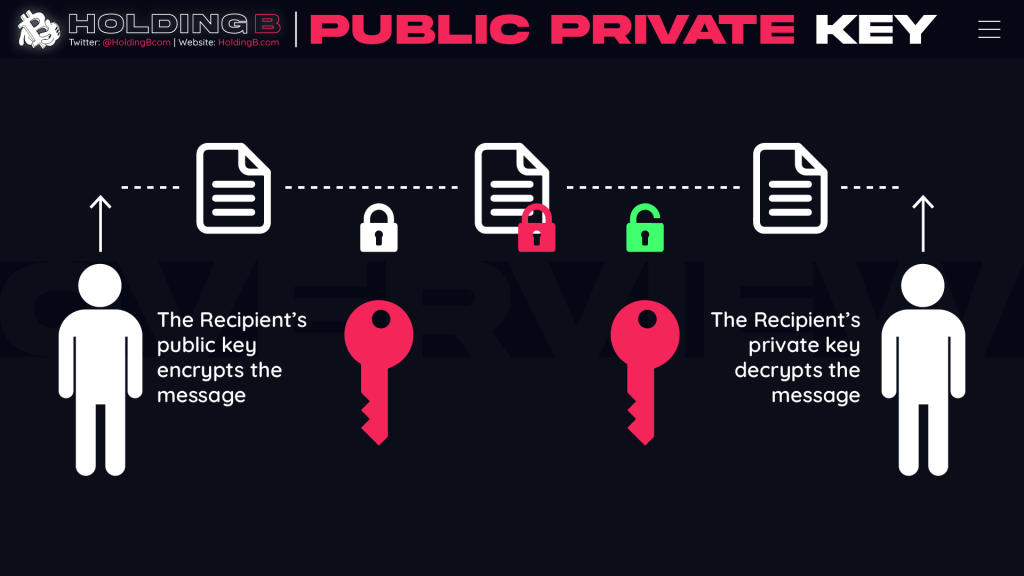
PUBLIC KEY
WHAT IS PUBLIC KEY ?
A public key allows you to receive cryptocurrency transactions. It’s a cryptographic code that’s paired to a private key. While anyone can send transactions to the public key, you need the private key to “unlock” them and prove that you are the owner of the cryptocurrency received in the transaction. The public key that can receive transactions is usually an address, which is simply a shortened form of your public key.
Therefore, you can freely share your public key without worry. You may have seen donation pages for content-creators or charities with the public keys for their crypto addresses online. While anyone can donate, you’d need the private key to unlock and access the donated funds.
WHAT IS PUBLIC-KEY CRYPTOGRAPHY?
Public-key cryptography (PKC) is a way to validate the authenticity of something using asymmetric encryption. PKC was first used primarily to encrypt and decrypt messages. Cryptocurrencies now use this technology to encrypt and decrypt transactions. Without PKC, cryptocurrencies wouldn’t be possible.
The key to PKC is “trapdoor functions,” one-way mathematical functions that are easy to solve in one way, but nearly impossible to crack in the reverse. While it might be possible, it would likely take a supercomputer — and thousands of years — to reverse engineer these functions.
HOW DOES PUBLIC KEY WORK ?

When a user initiates his or her first transaction in bitcoin or an altcoin, a public and private key pair is generated. Each key is a long string of alphanumeric characters that keep it safe for users to hold in the digital ecosystem. The private key is known to the user alone and serves as the user’s digital ID. The private key allows the user to spend, withdraw, transfer or make any other transaction from his account. A sophisticated algorithm is applied to the private key to generate a public key, and both keys are stored in a digital secret.
When a transaction is initiated by a user to send, for example, bitcoins, to another person, the transaction must be broadcast to the network where distributed nodes (i.e. those behind the computer) confirm the validity of the transaction. transaction before it is completed and recorded on the blockchain. Before the transaction is broadcast, it is digitally signed with the private key. The signature proves ownership of the private key, although it does not reveal the details of the private key to anyone. Since the public key is typed from the private key, the user’s public key is used to prove that the digital signature comes from his private key. Once the transaction has been verified as valid, the funds will be sent to the recipient’s public address.
The public address is the hashed version of the public key. Because the public key is made up of an extremely long string of numbers, it is compressed and shortened to form a public address. In effect, the private key generates the public key, which in turn generates the public address. When two people enter into an agreement in which one sends other tokens or coins, they reveal their public addresses to each other. A public address is like a bank account number. The sender needs the token to be able to send money to the receiver, who will then be able to spend or withdraw using his private key. The receiver can also verify the sender’s lot by using the sender’s public address which will be displayed on the sender’s screen.
Although the public key and address are processed from the private key, the reverse is almost impossible. The cryptocurrency network is secured using complex mathematical functions to ensure that the private key cannot be processed from the public key, especially since everyone on the network can see its public key and its hash. . Since it is not possible to regenerate a private key from a public key or an address, if a user loses his private key, any bitcoins or altcoins at his public address will be inaccessible forever. Otherwise, a user who loses his public key can be regenerated with a private key.
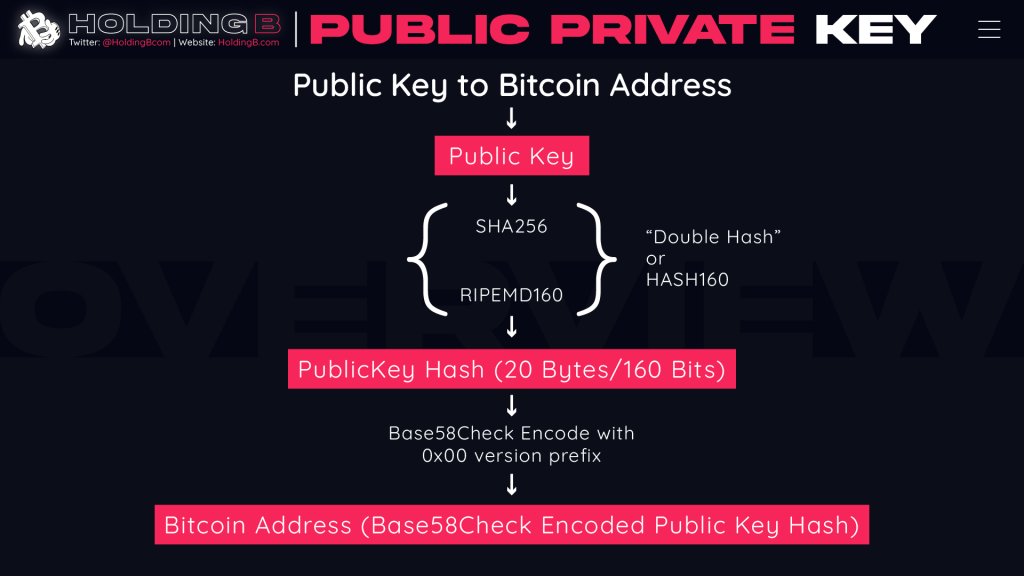
PRIVATE KEY
WHAT IS A PRIVATE KEY?
A private key is a secret number that is used in cryptography, similar to a password. In cryptocurrency, private keys are also used to sign transactions and prove ownership of a blockchain address.
A private key is an integral aspect of bitcoin and altcoins, and its security makeup helps to protect a user from theft and unauthorized access to funds.
- A private key is a secret number that is used in cryptography and cryptocurrency.
- A private key is a large, randomly-generated number with hundreds of digits. For simplicity, they are usually represented as strings of alphanumeric characters.
- A cryptocurrency wallet consists of a set of public addresses and private keys. Anyone can deposit cryptocurrency in a public address, but funds cannot be removed from an address without the corresponding private key.
- Private keys represent final control and ownership of cryptocurrency. It is vitally important to prevent one’s private keys from being lost or compromised.
- 3 main features of Private Key:
First: Private Key is a number represented by 256 Bit: Theoretically, we should have 2256 (~1077) Private Key, but in practice Bitcoin uses a standard called secp256k1 ECDSA and makes the sequence less than 1 slightly but not significantly, it’s still a large number that falls within that range and makes it impossible to guess.
Second: Losing the Private Key, your account will be lost forever: From the Private Key you can generate a Public Key, and from the Public Key you generate an address (Bitcoin address). However, the reverse process is not possible.
Third: How to generate Private Key?: For a Private Key to be valid, it needs to be a number represented in 256-bit form and satisfy the secp256k1 standard. Combining those two factors, we can write a script that randomly generates a 256-bit number between 0x1 and 0x1 to 0xFFFF FFFF FFFF FFFF FFFF FFFF FFFF FFFE BAAE DCE6 AF48 A03B BFD2 5E8C D036 4140.
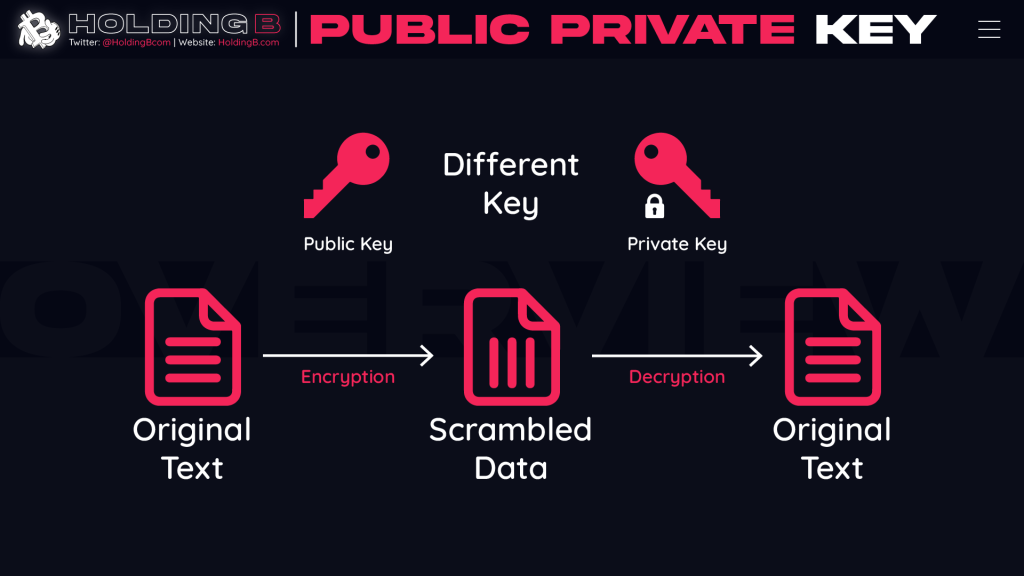
UNDERSTANDING PRIVATE KEYS
Cryptocurrency is controlled through a set of digital keys and addresses, representing ownership and control of virtual tokens. Anyone can deposit bitcoin or other tokens in any public address. But even though a user has tokens deposited into their address, they won’t be able to withdraw them without the unique private key.
Private keys can take a few different forms. In ordinary, base-ten notation, a private key would be hundreds of digits long–so long that it would take years to crack a private key by brute force. For simplicity, private keys are usually expressed as a string of alphanumeric characters
The public key is created from the private key through a complicated mathematical algorithm. However, it is near impossible to reverse the process by generating a private key from a public key.A similar algorithm is then used to create a receiving address from the public key. Think of the address as a mailbox, and the private key as the key to the box.
The mail carrier, and anyone really, can insert letters and small packages through the opening in the mailbox. However, the only person that can retrieve the contents of the mailbox is the one who has the unique key. It is, therefore, important to keep the key safe because if it is stolen or lost, the mailbox can be compromised.
DIGITAL WALLETS
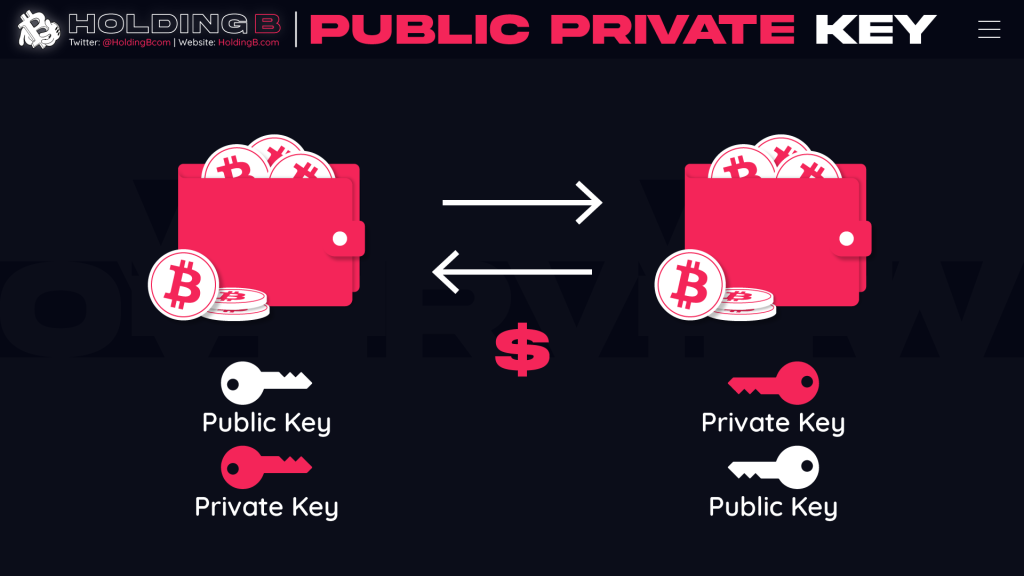
While private keys are essential to cryptocurrency, it is not necessary for a user to create or remember their own key pairs. Digital wallets are used to automatically create key pairs and store them safely. When a transaction is initiated, the wallet software creates a digital signature by processing the transaction with the private key. This upholds a secure system since the only way to generate a valid signature for any given transaction is to use the private key.
The signature is used to confirm that a transaction has come from a particular user, and ensures that the transaction cannot be changed once broadcasted. If the transaction gets altered, even slightly, the signature will be incorrect.
If a user loses their private key, they can no longer access the wallet to spend, withdraw, or transfer coins. It is, therefore, imperative to save the private key in a secure location. There are a number of ways that a digital wallet that contains a private key can be stored. Private keys can be stored on paper wallets, which are documents that have been printed with the private key and QR code on them so that they can easily be scanned when a transaction needs to be signed.
- IMPORTANT: Private keys can be stored using a hardware wallet that uses smartcards or USB devices to generate and secure private keys offline.
The private keys can also be stored using a hardware wallet that uses smartcards or USB devices to generate and secure private keys offline. An offline software wallet could also be used to store private keys. This wallet has an offline partition for private keys and an online division that has the public keys stored. With an offline software wallet, a new transaction is moved offline to be signed digitally and then moved back online to be broadcasted to the cryptocurrency network.
These types of storage mentioned above are called cold storage, as private keys are stored offline. The other type of wallet, hot wallet, stores private keys on devices or systems that are connected to the internet. Examples of these wallets include desktop wallets (e.g., Electrum), mobile wallets (e.g., Breadwallet), and web-based wallets (e.g., Coinbase).
HOW DO PRIVATE KEYS WORK?
A private key is an extremely large number that is used in cryptography, similar to a password. Private keys are used to create digital signatures that can easily be verified, without revealing the private key. Private keys are also used in cryptocurrency transactions in order to show ownership of a blockchain address.
When dealing with cryptocurrencies, users are usually given a public address and a private key to send and receive coins or tokens. The public address is where money is sent and received. But even if a user has tokens deposited in his address, he can withdraw them without a private key. The public key is generated from the private key through a complex mathematical algorithm. However, it is nearly impossible to reverse the process by generating the private key from the public key.
The private key can take a few different forms, often described as a series of alphanumeric characters, making it difficult for hackers to crack. Most users represent their wallet key in wallet input format, which is 51 characters. Think of a public address as a mailbox, and the private key is the key to the box. Postmen, and anyone really, can insert letters and small packages through the opening in the mailbox. However, the only person who can retrieve the contents of the mailbox is the person with the unique key. Therefore, it is important to keep the key safe because if it is stolen or received without authorization, the mailbox can be compromised.
A digital wallet that stores a user’s private key. Once a transaction is initiated, the wallet software generates a digital signature by processing the transaction with the private key. This maintains a secure system as the only way to generate a valid signature for any given transaction is to use a private key. The signature is used to confirm that a transaction has come from a particular user and to ensure that the transaction cannot be changed once it is broadcast. If the transaction is changed, even slightly, the signature will change.
If a user loses their private key, they cannot access the wallet to spend, withdraw, or transfer funds. Therefore, it is imperative to store the private key in a secure location. There are several ways that digital wallets containing private keys can be stored. The private key can be stored on a paper wallet which is a document that has been printed with the private key and a QR code on it so that it can be easily scanned when a transaction is needed.
The private key can also be stored with a hardware wallet that uses a smart card or USB device to generate and secure the private key offline. An offline software wallet can also be used to store private keys. This wallet has an offline partition for private keys and an online partition where public keys are stored. With an offline software wallet, a new transaction is transferred offline to be digitally signed and then moved back online to be broadcast to the crypto network.
WHAT IS THE BEST WAY TO STORE PRIVATE KEYS?
Private keys can be stored on computers or mobile phones, USB drives, a specialized hardware wallet, or even a piece of paper. The ideal form of storage will depend on how often you plan to use your cryptocurrency. A password-protected mobile phone or computer is the most convenient way to store cryptocurrency for everyday use. For long-term or “cold” storage, private keys should always be kept offline, ideally on devices that have never touched the internet. Even printers can be compromised. Hardware wallets can facilitate cold storage by signing transactions in a way that does not compromise the private keys.
HOW IS A PRIVATE KEY GENERATED?
Keeping things straightforward, a private key is generated by a random number generator. You can even do it by yourself! A private key is a 256-bit number. This means that it is represented in binary in 256 numbers of 0 or 1. In total, this means there are a total of (almost) 2^256 combinations of private keys.
This number can also be expressed as 10^77 for simplicity. For rounding purposes these numbers are almost the same. Once again, it is fortunate that most wallets can generate you a list of private keys at the push of a button.
Is it possible for duplicate private keys to be generated?
Given that private keys are assigned randomly, it is in fact true that two wallets could both come up with the same private key. As stated above the amount of private key combinations is represented by the number 10^77. This is 10 followed by 77 zeroes! In comparison, there’s roughly 10^18 grains of sand on planet earth.
It is an unfathomable number so you’ll have to just take our word for it- it is almost impossible. But what about the threat of Quantum computing?
PUBLIC AND PRIVATE KEYS CONTROL YOUR CRYPTO
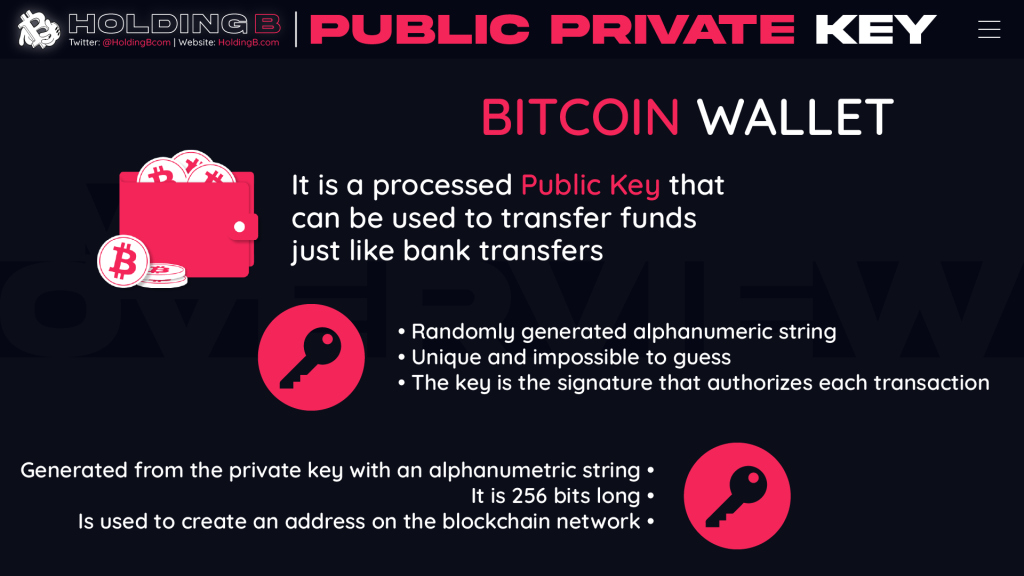
How public and private keys work together is fundamental to understanding how cryptocurrency transactions function. When you say you have cryptocurrency, what you’re really saying is you have a private key that proves ownership of that cryptocurrency. Since it’s stored on the blockchain, anyone can verify you as the owner with your public key.
The choice of “holding your own keys” or trusting a custodian depends on your philosophy, risk-tolerance, and a host of other factors. If you hold your own private keys, consider modern HD wallets, which can do a great job of managing your private keys, and remember to never share them. If you choose a custodial solution like an exchange, make sure you choose a trusted, reputable company that places a high emphasis on security and regulation.
- Example so you can better understand the topic Public key/Address and Priᴠate keу
Let’s look at how a Bitcoin transaction works.
If Tom transfers 1 amount of Bitcoin to Jennу. To transfer Bitcoins, you need 2 things: a Bitcoin address and a private key. A Bitcoin address is randomly generated, it’s simply a string of letters and numbers. A private key is also another string of letters and numbers, but unlike a Bitcoin address, it is kept secret.
Imagine your Bitcoin wallet as a safe deposit box with a front glass. Everyone can tell what’s inside it, but only the Priᴠate key can open it and take everything away or give everything away.
When Tom wants to transfer Bitcoins to Jenna, he will use his Priᴠate key to sign a message with Input Source (transactional source of Bitcoin ), Amount, Output Source (Jenna’s Bitcoin address).
He then transfers them from his Bitcoin wallet to the vast Bitcoin network. From this network, Bitcoin miners will confirm the transaction, place it in a transaction block and finally the transaction is settled.
Simply put:
- The public key is the equivalent of your email address.
- The private key is the equivalent of the password you use to log in to your email account.
If you want to initiate a transaction with BTC, you need:
Sign up for an account on CoinBae to convert dollars, euros, pounds, and major cryptocurrencies. Some hardware like the Ledger Nano S – this is the only thing on the list you will have to pay for, and it is absolutely most important.A free Binance account – you can deposit cryptocurrencies you buy on Coinbase to Binance and exchange them for all the best altcoins. Free Google Authenticator app – two-factor authentication factor that significantly reduces your chances of taking over your account.
Bitcoin in particular and virtual money in general are becoming dominant and hot fields in recent times, knowledge about them and blockchain can open up a lot of new opportunities.
- COMPARE PUBLIC KEY AND PRIVATE KEY
| PUBLIC KEY | PRIVATE KEY |
| Allow to receive coins. Used for account identification. Anyone can search it on the blockchain ledger | Allow to connect and use your coins. Used to prove you are the owner of the Public key |
| No need to keep it a secret | Must be kept secret |
| Can’t find the Private key from the Public key | It is possible to find the Public key from the Private key |
| Your property will not be affected if you reveal the Public key | High probability of losing your property forever if you lose your Private key |
| The shortened version is called an address. | There is no shortened version |





